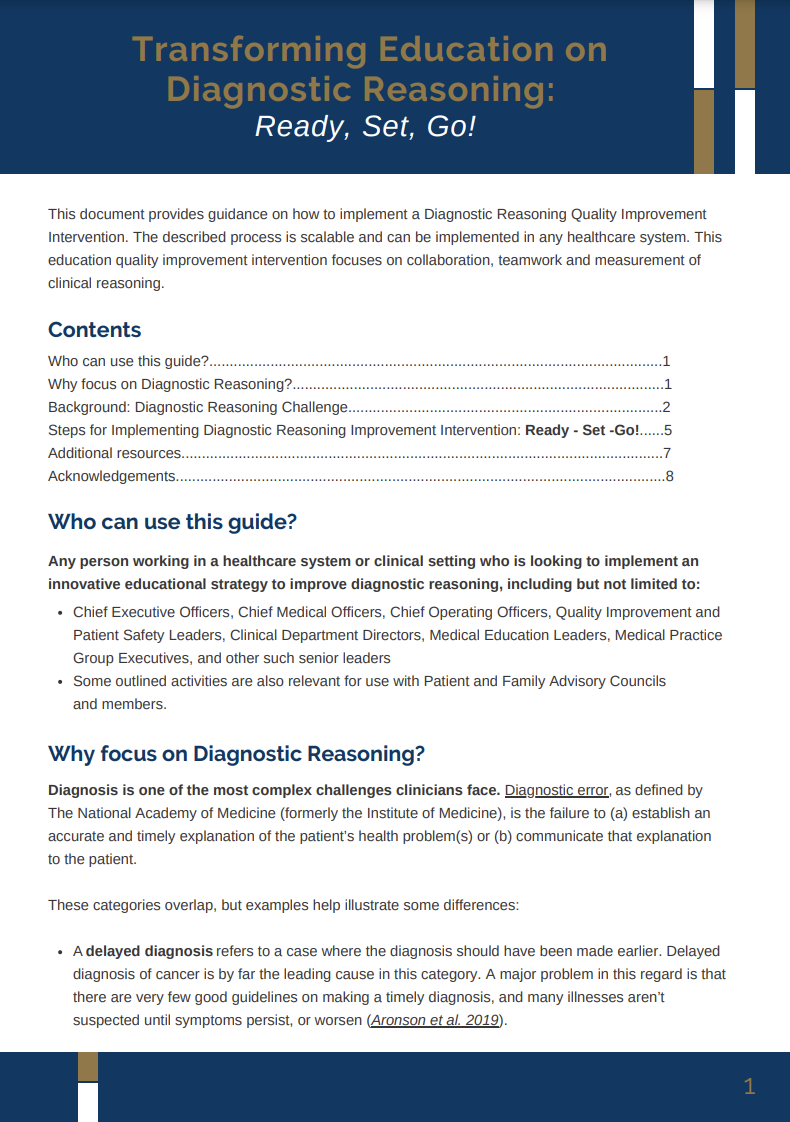New Implementation Guide Focuses on Transforming Education of Diagnostic Reasoning
The Society to Improve Diagnosis in Medicine (SIDM) has partnered with the Southern California Permanente Medical Group (SCPMG) and the Human Diagnosis Project (Human Dx) through a grant from the Coverys Foundation to create an education intervention to practicing physicians' diagnostic reasoning. The newly developed implementation guide, Transforming Education on Diagnostic Reasoning: Ready, Set, Go!, describes how to implement a diagnostic reasoning quality improvement intervention that is scalable and can be carried out in any healthcare system.
Why diagnostic reasoning?
Diagnosis is one of the most complex challenges clinicians face. An estimated 40,00 to 80,000 people die each year from diagnostic failures in U.S. hospitals alone. Diagnostic errors that arise through cognitive errors are often associated with faulty perception, failed heuristics, and biases. Clinicians rely on these shortcuts in reasoning to minimize delay, cost, cognitive load, and anxiety in their clinical decision-making. In an analysis of a large medical malpractice claims database, failures in clinical judgment were the leading identified cause of serious misdiagnosis-related harms.
While resources aimed towards increasing awareness and reducing the rate of diagnostic errors are available for physicians in training, few collaborative educational programs are available for practicing clinicians.
With this guide, leaders are shown ways to define the problem and establish a goal, prepare communication plans and curate educational materials, and ultimately measure the effectiveness of the intervention.
“The implementation guide offers practical guidance on how to implement a diagnostic reasoning improvement intervention for busy clinicians,” says Gerry Castro, Ph.D., MPH, PMP, SIDM’s Director of Quality Improvement, “Our partners at SCPMG and Human Dx contributed not only technical expertise but real-world experience to the content of the implantation guide”
Who should use this guide?
Any person working in a healthcare system or clinical setting who is looking to implement an innovative educational strategy to improve diagnostic reasoning, including but not limited to:
- Chief Executive Officers, Chief Medical Officers, Chief Operating Officers, Quality Improvement and Patient Safety Leaders, Clinical Department Directors, Medical Education Leaders, Medical Practice Group Executives, and other such senior leaders
Diagnostic reasoning challenge
During the project, SIDM, Human Dx, and SCPMG aimed to assess outcomes in clinical reasoning, diagnostic accuracy, and collaboration in an innovative virtual educational format.
Human Dx provided Global Morning Report (GMR) clinical cases focused on diagnostic reasoning in the following three areas: infectious diseases, cardiology, and cancer. SCPMG recruited participants and administered the educational platform, materials, and administrative support throughout the quality intervention, while SIDM provided consultative support for the project.
The project consisted of physicians from three Kaiser Permanente regions, who participated in solving a set of Human Dx/GMR cases, engaging in a 6-week intervention phase, and again asked to solve a set of Human Dx/GMR cases differing from the first.
Funding for Human Dx and SIDM was provided through a grant from the Coverys Community Healthcare Foundation

